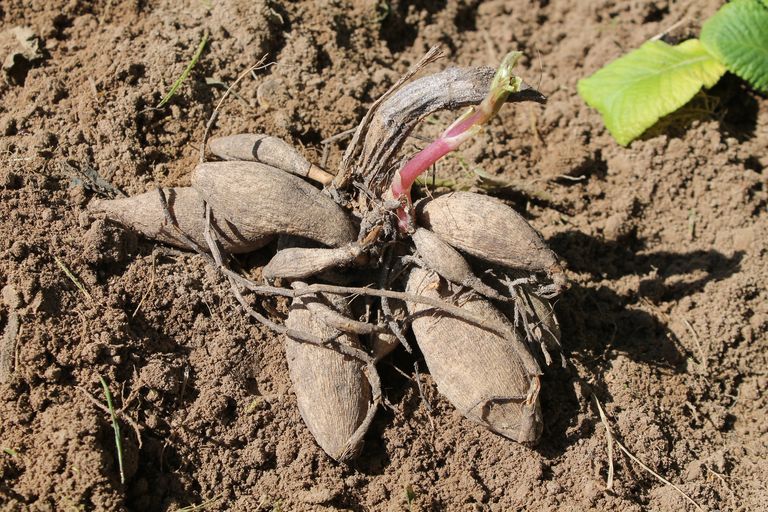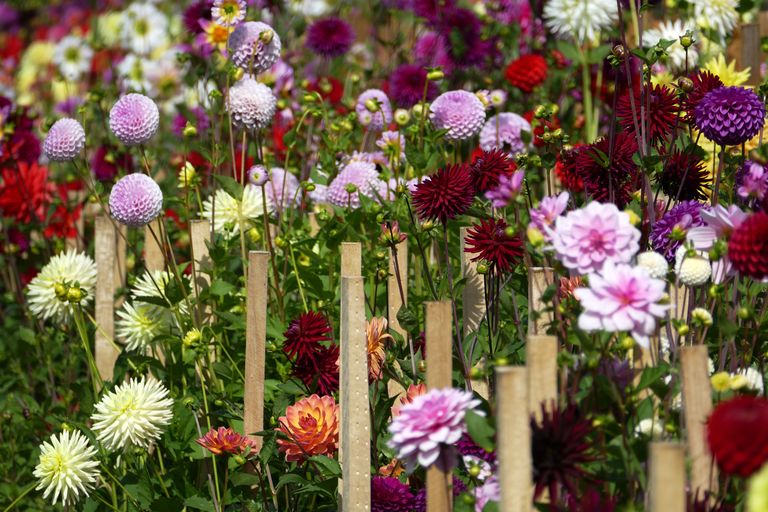![[feature] How to grow dahlias](https://blogger.googleusercontent.com/img/b/R29vZ2xl/AVvXsEj7tb5o2vbKgjUiJ0klv671nRtQWU8wJLMmKWhRCKsORsj0L2OTNSWt4mt7CKIr9q4S82qRP75uyl7-sJeQQlMTzBq0ZdYzWMFxh7t2_kA2xrfYO66XSl32mSg2o2gHtPdM8zP3BPoGqBg/s16000/Dahlias.jpg) |
| © Caiaimage / Marie StoneGetty Images |
By Simon Swift and Adrienne Wild, Good Housekeeping
Although originally a native of Mexico, dahlias have become a British classic. A few years ago though, they fell out of favour with gardeners who thought of them as old fashioned and a gaudy, time consuming plant that their great granddads grew on their allotments.
Fortunately after decades in the doldrums, they are enjoying a revival due to their vast colour range and fantastic flower power – those with single blooms are also a magnet to bees and butterflies. This has made them a real crowd pleaser and popular garden plant and especially with millennials, inspired by Instagram.
There are many different varieties of dahlias from pom pom to cactus varieties.
Today you’ll find dahlias being grown patio pots and in trendy exotic style and colour-themed borders and they are a must-have for the cutting patch. The flowers in softer shades are often a top choice, as they not only provide armfuls of cut flowers to fill your vases every day throughout the summer but make knockout bouquets, so have become a brides’ favourite.
You’ll find dahlias come in various shapes and sizes, from the tiny pompons and those that resemble other familiar blooms such as water lilies, peonies and chrysanthemums to spiky-petal cactus types and eye-catching giants like ‘Bilbao’ and ‘Manhattan Island’ whose flowers are the size of a dinner plate plus many more. They come in almost every colour and colour combination too, except the elusive blue and also with foliage from dark green to dark bronze.
To grow the best, you'll need to find your dahlias a sunny spot. The key to success however, lies in the soil. Dahlias require good drainage and are heavy feeders so enriching the soil before planting with well-rotted garden compost or manure will pay dividends as will ‘feeding’ the plants throughout the growing season.
It’s important too, to keep your dahlia beds weed-free as they will compete for water, nutrients, and light, and often harbour pests and diseases. Mulches are effective in controlling weeds and will also keep the soil cool and conserve moisture, which is important, as dahlias are super thirsty plants.
Taller varieties also need to be staked as their hollow stems can often break under the weight of their large blooms. Put stout stakes in at planting time and use soft string to loosely tie the stems to avoid constricting the developing plant. When the plant is about 20cm, it will set a terminal flower bud.
Pinching out the tips as they grow will encourage branching and more flowers, so if you want a bushy plant with masses of flowers, rather one big beautiful bloom, remove this bud and any small buds next to it. Remove all spent flowers complete with the stem regularly to keep the plant productive otherwise it will run to seed.
Surrounding the plant with crushed eggshells or a ring of copper wire may keep slugs and snails at bay or you could use their natural enemy, nematodes, which are available from garden centres and only need mixing with water and applied to the ground through a watering can. Although they will not destroy large, surface living slugs, nematodes will kill young and small slugs in the soil.
Earwigs are also easily controlled by simply sticking the odd tall, bamboo cane throughout your patch, with an upside-down pot speared on each, stuffed with damp straw, grass or hay. Earwigs like to hide in it during the day and so are easy to trap. In the morning empty the pot and dispose of them.
Although originally a native of Mexico, dahlias have become a British classic. A few years ago though, they fell out of favour with gardeners who thought of them as old fashioned and a gaudy, time consuming plant that their great granddads grew on their allotments.
Fortunately after decades in the doldrums, they are enjoying a revival due to their vast colour range and fantastic flower power – those with single blooms are also a magnet to bees and butterflies. This has made them a real crowd pleaser and popular garden plant and especially with millennials, inspired by Instagram.
 |
| © Anke Wittkowski / EyeEm / Getty Images |
Today you’ll find dahlias being grown patio pots and in trendy exotic style and colour-themed borders and they are a must-have for the cutting patch. The flowers in softer shades are often a top choice, as they not only provide armfuls of cut flowers to fill your vases every day throughout the summer but make knockout bouquets, so have become a brides’ favourite.
You’ll find dahlias come in various shapes and sizes, from the tiny pompons and those that resemble other familiar blooms such as water lilies, peonies and chrysanthemums to spiky-petal cactus types and eye-catching giants like ‘Bilbao’ and ‘Manhattan Island’ whose flowers are the size of a dinner plate plus many more. They come in almost every colour and colour combination too, except the elusive blue and also with foliage from dark green to dark bronze.
When to plant dahlias
Whilst they can be grown from seed, all but the dwarf bedding types are generally grown from tubers, which makes them one of the easiest plants of all to grow – when the risk of frost is past, you simply dig a hole and plop them in the ground. |
| © kazakovmaksim / Getty Images |
To grow the best, you'll need to find your dahlias a sunny spot. The key to success however, lies in the soil. Dahlias require good drainage and are heavy feeders so enriching the soil before planting with well-rotted garden compost or manure will pay dividends as will ‘feeding’ the plants throughout the growing season.
How to grow dahlias
Dahlias utilize large amounts of potash for root development and potassium for flower production so look for a fertiliser that is high in these nutrients and contains only small amounts of nitrogen for maintaining healthy growth.It’s important too, to keep your dahlia beds weed-free as they will compete for water, nutrients, and light, and often harbour pests and diseases. Mulches are effective in controlling weeds and will also keep the soil cool and conserve moisture, which is important, as dahlias are super thirsty plants.
Taller varieties also need to be staked as their hollow stems can often break under the weight of their large blooms. Put stout stakes in at planting time and use soft string to loosely tie the stems to avoid constricting the developing plant. When the plant is about 20cm, it will set a terminal flower bud.
 |
| © kodachrome25 / Getty Images |
Pinching out the tips as they grow will encourage branching and more flowers, so if you want a bushy plant with masses of flowers, rather one big beautiful bloom, remove this bud and any small buds next to it. Remove all spent flowers complete with the stem regularly to keep the plant productive otherwise it will run to seed.
How to protect dahlias
As dahlias are delicious meals for caterpillars, which chew holes in their leaves by day and their juicy leaves and glorious blooms are the preferred mid-night snack for slugs and earwigs, you’ll need to set traps to protect the plants. Slugs thrive anywhere that moisture may be retained, so common places to find slugs will be under pots and containers, under mulch, under boards, under rocks and deep in overgrown vegetation. |
| © jeffhochstrasser / Getty Images |
Surrounding the plant with crushed eggshells or a ring of copper wire may keep slugs and snails at bay or you could use their natural enemy, nematodes, which are available from garden centres and only need mixing with water and applied to the ground through a watering can. Although they will not destroy large, surface living slugs, nematodes will kill young and small slugs in the soil.
Earwigs are also easily controlled by simply sticking the odd tall, bamboo cane throughout your patch, with an upside-down pot speared on each, stuffed with damp straw, grass or hay. Earwigs like to hide in it during the day and so are easy to trap. In the morning empty the pot and dispose of them.
How to cut dahlias
To use dahlias as cut flowers, cut the blooms when they are fully open. Condition the flowers immediately after cutting by plunging the cut ends into warm water immediately, then when you're ready to arrange them in the vase, cut off about 1mm of the stem base and place the stems in warm water. Doing this, along with changing the water every 2–3 days will increase the life of the flowers in the vase.Overwintering dahlia tubers
Dahlias, which will have been blooming from around late July will have their lives cut short when a frost blackens the foliage. After this, plants can then be cut back to about 15cm and dug up and stored in a cool, frost-free place for the winter. |
| © Barbara Rich / Getty Images |
Treat the tubers with care before storing them. Allow the hollow stems to drain by standing them upside down in a tray and after a coupe of weeks, remove dried soil clinging on to the tuber with a soft brush and dust them with yellow sulphur to discourage mould and mildew, then stand the tubers upright in a storage box and cover with slightly damp peat or sand.
It’s a good idea to check your dahlia tubers regularly throughout the winter to look for signs of mildew or rotting. Cut out any affected areas with a clean sharp knife then dust with sulphur.
Dormant tubers can be revived in spring by planting them in pots and any shoots can be used for cuttings, which are grown on in individual pots and planted out in May and June. Dry tubers can be planted where you want them to flower in late April.
See more at Good Housekeeping






















